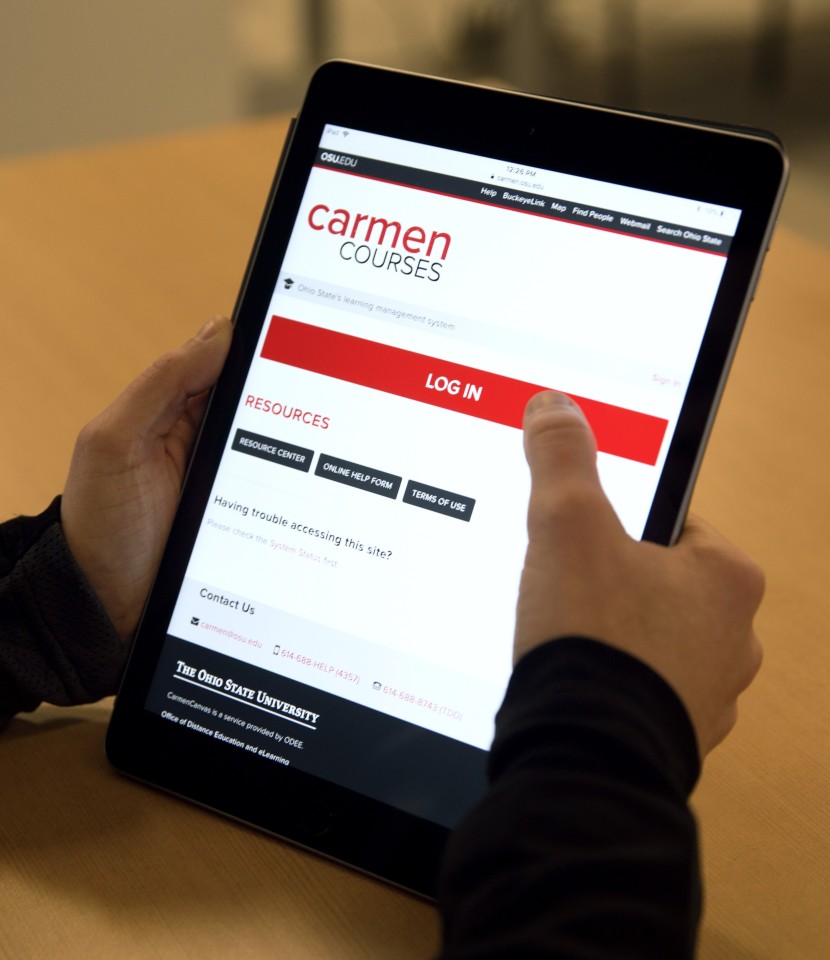
Professor Buckeye is selecting learning technologies for the first class she's teaching at Ohio State, a course on digital marketing trends.
She knows CarmenCanvas is Ohio State’s learning management system (LMS) and should be the hub for her course materials. But Professor Buckeye doesn't know about the other available tools at Ohio State. She incorporates several apps that students might encounter in their future marketing careers into learning activities. A third of the tools store student data in the cloud, half require a paid subscription, and one is not accessible to screen readers.
Professor Buckeye’s choices could infringe on students’ privacy, violate FERPA, and negatively impact access and learning. What could she have done differently?
Ohio State provides faculty, staff, and students access to numerous learning technology tools and applications to enhance teaching and learning. This guide will provide an introduction to those tools and the benefits of university-supported and vetted tools so you can make informed choices about the technology you use in your teaching.
What are learning technologies?
Learning technologies are the broad range of communication, information, and related technologies that are used to support learning, teaching, and assessment in an in-person, hybrid, or online course (Association for Learning Technology, 2020). Some of their uses include:
- managing course materials
- fostering discussion in and outside of class
- authoring learning materials
- sharing media files
- assessing learning
Examples of learning technologies include learning management systems (LMS) such as CarmenCanvas or student response systems like Top Hat.
What tools are available at Ohio State?
There are two levels of tools available to instructors and students at Ohio State: university-supported tools and university-vetted tools.
Both types of tools have been through a rigorous assessment process to evaluate security, accessibility, and risk. However, university-supported tools are ones for which the university offers technical assistance through the IT Service Desk. University-vetted tools are not supported university-wide and may or may not be supported by your department or unit, but they have been through the tool evaluation process.
Learning Systems toolset

The Learning Systems toolset is available for free to all faculty, staff, and students and is centrally supported by the Office of Technology and Digital Innovation’s (OTDI) Learning Systems Support Team.
- CarmenCanvas is Ohio State’s learning management system (LMS) for in-person and online courses, powered by Canvas. Carmen, as it’s often called, is used as a hub for course content, assignments, grades, communication, and more. It is the foundation for building and integrating other tools into your course.
- CarmenZoom is the academic audio and web conferencing platform for Ohio State, used for remote teaching, advising, appointments, group projects, recording video lectures, and more.
- Mediasite is the university’s video and lecture capture tool used to record class sessions or lectures using a Hardware Recorder, screen or slide share with audio or video from a desktop computer, and upload recordings to university servers.
- PebblePad is Ohio State’s ePortfolio service, used to develop digital portfolios and curate and manage evidence of reflection, learning, assessment, and professional development. Ohio State adopted PebblePad to support the university’s general education (GE) program.
- Top Hat is a web-based student response system that allows you to create an interactive lecture experience for students. Use Top Hat to poll students, present discussion prompts, display lecture material, track attendance, and sync grades with Carmen. Students can respond to Top Hat questions and prompts using the devices they already own, such as smartphones, laptops or tablets.
- U.OSU is the university's easy-to-use professional website platform. U.OSU supports Ohio State faculty, staff, and students' professional and educational activities. Use it to share your independent work, host course assignments, enhance project visibility, communicate within groups, and represent your organizations.
Browse all the toolset guides and resources.
Additional tools
In addition to the supported Learning Systems toolset, various tools have been through the vetting process but may or may not be supported by individual colleges or units. Some examples include:
- Microsoft 365 is available to all Ohio State students, faculty, and staff who have free access to the suite of desktop and mobile apps, including Word, Excel, OneNote, PowerPoint, Sway and Whiteboard.
- Adobe Express is available for free to all Ohio State students, faculty and staff. Adobe Express is an all-in-one web app for photos, videos, documents and graphic design. In addition, Adobe Creative Cloud is available for free in Digital Unions, public computer labs, and computer lab classrooms. Ohio State students, faculty, and staff can also purchase an annual license at a discounted rate. Learn more about the capabilities of Adobe tools and find out if they may enhance your students learning experience.
- CarmenCanvas integrations are third-party applications with enhanced or specialized functions outside of those provided within Carmen. These approved integrations allow students to access resources related to their course through Carmen, even though they are housed in another online system. Depending on the integration, you may be able to transfer content, assignments, and grades from the integrated application into Carmen. Examples include publisher tools, CarmenBooks, H5P, Namecoach, Nearpod, and many others.
See the full list of additional tools.
Campus classroom technology
Pool classrooms supported by the Office of Technology and Digital Innovation (OTDI) vary from room to room, but all will include a projector, a wall-mounted camera, and an in-room microphone to assist with lecture recording or simulcasting. Your department or unit may provide additional classroom technology.
Learn more about available classroom technology and support.

What are the benefits of university-supported and vetted tools?
When you use university-supported tools and other approved technologies in your course, you can be confident that they have been vetted by Ohio State for security, accessibility, and privacy. This enables you to focus on teaching without worrying about barriers for your students or potential legal liabilities. Additionally, technical support for the Learning Systems toolset is provided by knowledgeable staff right here at Ohio State.
There are various factors considered when tools are evaluated for use at the university, including:
Cost
All university-supported tools are free to students and faculty. If the university does not adopt a tool, your college or department can adopt a vetted tool, which may require additional funding from your unit or department.
Accessibility
The learning technology approval process includes evaluations for accessibility to be sure that tools are compatible with screen readers or other assistive technology devices, that non-mouse users can navigate the technology, and that students do not encounter other difficulties because of visual, auditory, or cognitive disabilities. If a tool is not completely accessible, there will be mitigations in place to provide users with the assistance they need.
Learn more about Learning Systems toolset accessibility support.
Security
Ohio State's Risk Management team evaluates all tools for potential vulnerabilities. The risk assessment considers network security; data security, transmission and storage; resiliency; and privacy.
FERPA compliance
The Family Educational Rights and Privacy Act (FERPA) was passed to enact protections around student grades and who they can be shared with. Not all learning technologies are FERPA-compliant, and whether they are may depend on how you use them. University-supported tools are selected and configured for optimum compliance. Read the FERPA guidelines and always keep them in mind while maintaining and delivering your course.
How do I get technical support?
As mentioned above, one of the benefits of using university-supported tools is that they are supported by the Office of Technology and Digital Innovation.
The IT Service Desk offers 24-hour support, seven days a week.
- Phone: 614-688-4357 (HELP)
- Email: ServiceDesk@osu.edu
- Self Service and Chat Support: go.osu.edu/IT
- Online support forms
In-person support is available on Columbus and regional campuses through BuckeyeBar.
Support for university-vetted tools varies. See the additional tools guide for more information on individual tools and where to get technical support.
What about other tools?
Using tools that have not been through the Ohio State vetting process could cause a variety of negative outcomes for students, instructors, and the university. It's important to be aware of potential consequences, including:
- Cost to students: Students are more likely to incur additional expenses or encounter technical issues that the university cannot help them work through. Both factors create barriers to academic success.
- Student data security concerns: Student data can become vulnerable, potentially being exploited in ways that cause harm and create instructor liability for said harm.
- Breach of student privacy: Grades and personal information cannot occur through the tool without violating FERPA guidelines and exposing the instructor to legal risk.
- Inaccessible tools: Tools may be incompatible with screen readers or other assistive technology devices, making it difficult or impossible for students reliant on them to use.
- Unexpected tool changes: Because there is no contract in place, the vendor can change the settings and functions of a tool at any time, potentially making them inoperable mid-term.
- No integration with Carmen: There will be no integration with other Ohio State systems, meaning student activity data cannot be imported into Carmen.
- Wasted student effort: Students might learn to use the tool for just one class in one semester, which may not feel like a useful expenditure of time or effort, particularly if the tool is complex or does not help students meet one of your learning outcomes.
How do I initiate the university tool approval process?
When you are selecting tools for your course, it’s important to be aware of Ohio State’s existing approved tools and the tool approval process. The tool approval process involves various units across the university addressing considerations such as technology, security, legal, and accessibility.
Keep in mind that the vetting process does not guarantee a tool will be centrally supported or funded. It simply means the university has determined it meets the criteria for use at Ohio State. This section addresses frequently asked questions and how to initiate the tool review process.
Is your chosen tool approved?
Before choosing a tool for your course, you should check the currently vetted tools first to see if one will meet your needs.
In addition to the Learning Systems toolset and additional tools list, other valuable resources for already vetted tools at the university are the Cloud Assessment Registry and Cloud Services Registries, which allow university employees to identify cloud platforms that have already been evaluated.
- Cloud Assessment Registry: This registry provides information on third-party applications that have been evaluated as meeting the criteria for use at Ohio State.
- Cloud Services Registry: This registry provides information on the Third-Party Risk Assessments performed on Amazon Web Services and Microsoft Azure infrastructure as a Service (IaaS) and Platform as a Service (PaaS) products.
If a tool you would like to use is not on the registry, it is possible it's been approved for your specific unit or department. The first step is to check with your local instructional technology staff, IT staff, or security coordinator to determine which tools are available for departmental use.
If the tool you’re interested in using is not currently vetted, you can initiate the proper reviews to get things rolling; see below for more information.
How do I get a tool approved?
If none of the currently supported or approved tools meet your needs, we recommend that you first reach out to your local instructional technology or IT staff to share your ideas. They may be able to help you accomplish your goals with existing tools. If not, they can help you navigate the tool approval process.
Tools must go through various reviews including a security risk assessment and accessibility review, which can be completed concurrently, and a possible legal review. A legal review will be undertaken if there is a cost associated with the use of an application, student-paid or otherwise.
Instructors and their unit/departments are responsible for initiating and completing all reviews.
How long does the tool approval process take?
You should submit your requests as soon as possible, as it could take at least three months to vet each tool, and there is no guarantee that it will be available for a certain semester.
Who pays for a tool?
If a tool has a cost associated, the cost is the responsibility of the user or unit/department making the request, or a student-pay model may be implemented. University-supported tools are centrally funded and are free to faculty, staff, and students.
How do I choose learning technologies for my course?
By thoughtfully leveraging Ohio State technology in your teaching, you can find new ways to share course content, foster student engagement, promote connection and collaboration, support critical thinking, and encourage creativity and expression.

Browse our growing repository of teaching topics for suggestions on how to effectively incorporate learning technologies into your course. For example:
- Integrating Technology into Your Course: Explores strategies for incorporating technology into your course and choosing appropriate tools for your course.
- Carmen Common Sense: Best Practices: A student-authored list of ten suggestions for a student-friendly Carmen course.
- Creating an Positive Learning Environment in CarmenZoom: Strategies for fostering student participation in synchronous meetings.
- Best Practices for Recording Lecture Videos: Explores best practices and strategies for creating effective and engaging lecture videos using university-supported tools.
- AI Considerations for Teaching and Learning: Learn about generative artificial intelligence, its benefits and limitations, and how it can be effectively integrated into learning environments.
See On-Demand Learning Opportunities to explore a range of workshop videos and register for asynchronous courses on teaching with technology and teaching online.
Summary
Ohio State offers a variety of supported and vetted learning technologies to enhance teaching and learning in your courses. Using supported and vetted tools ensures that they have been reviewed for:
- security
- accessibility
- privacy
You can receive technical support from the IT Service Desk for supported tools.
Using unvetted technology tools can cause a variety of negative outcomes for students, instructors, and the university including:
- additional costs to students
- data security and privacy concerns
- inaccessible tools
- no integration with Carmen
Before choosing tools for your course, check the currently vetted tools first to see if one will meet your needs. If not, you can reach out to your local instructional or IT staff to initiate the tool approval process. Keep in mind it is a lengthy process, so reach out as early as possible to begin the reviews!
Explore
Learning Opportunities
References
Association for Learning Technology. (2020, February 10). What is Learning Technology? Retrieved September 19, 2023, from https://www.alt.ac.uk/about-alt/what-learning-technology

